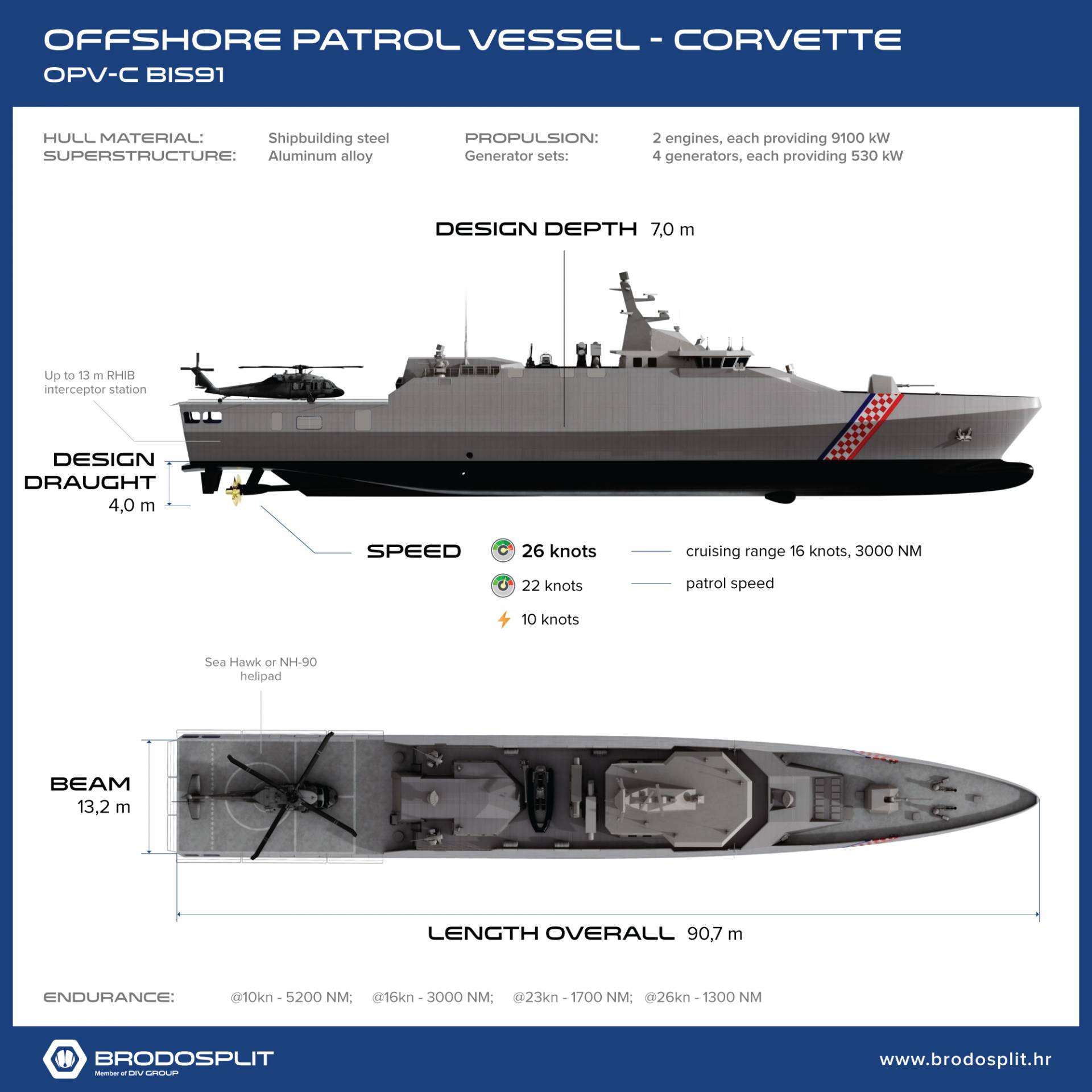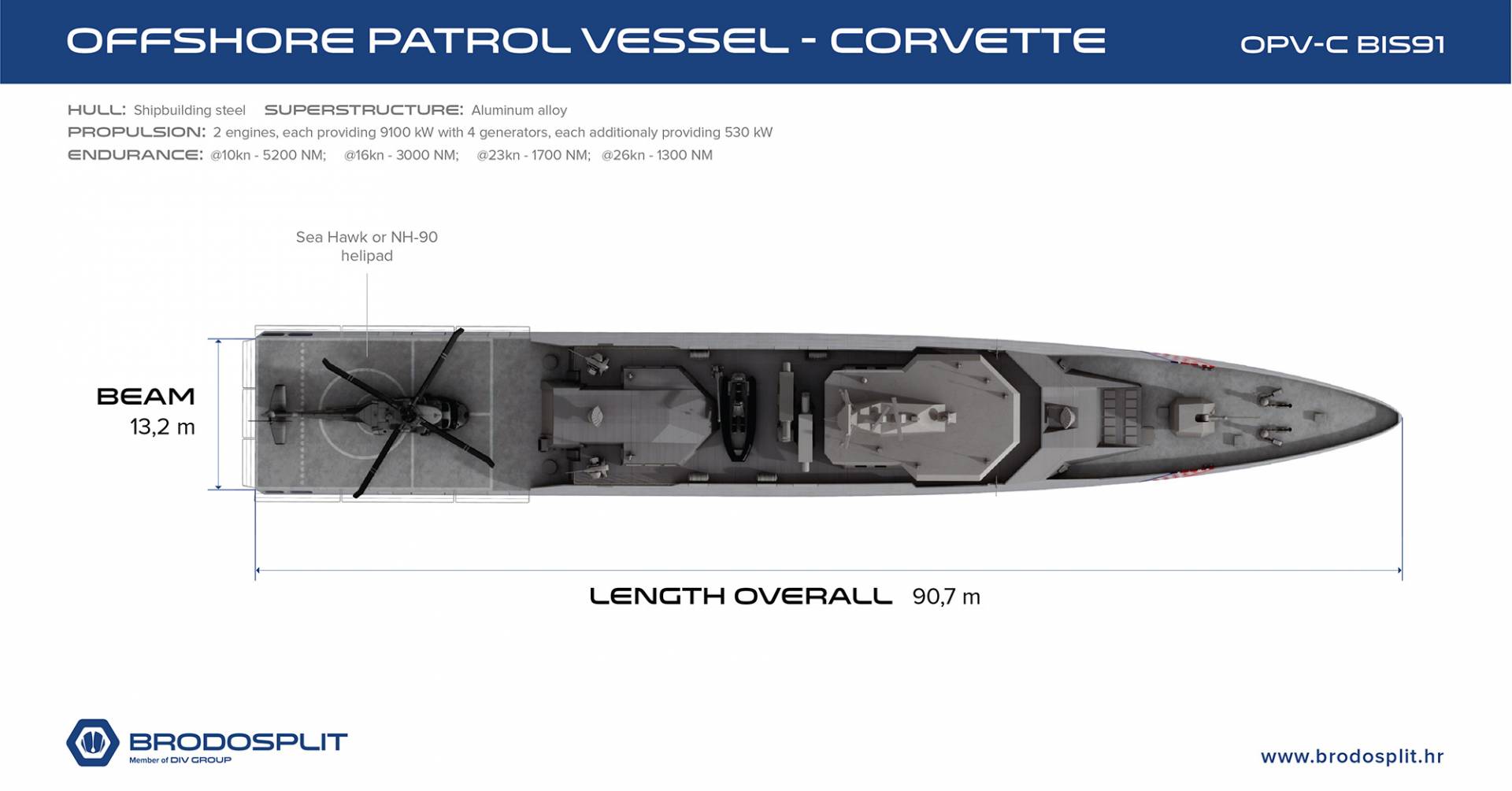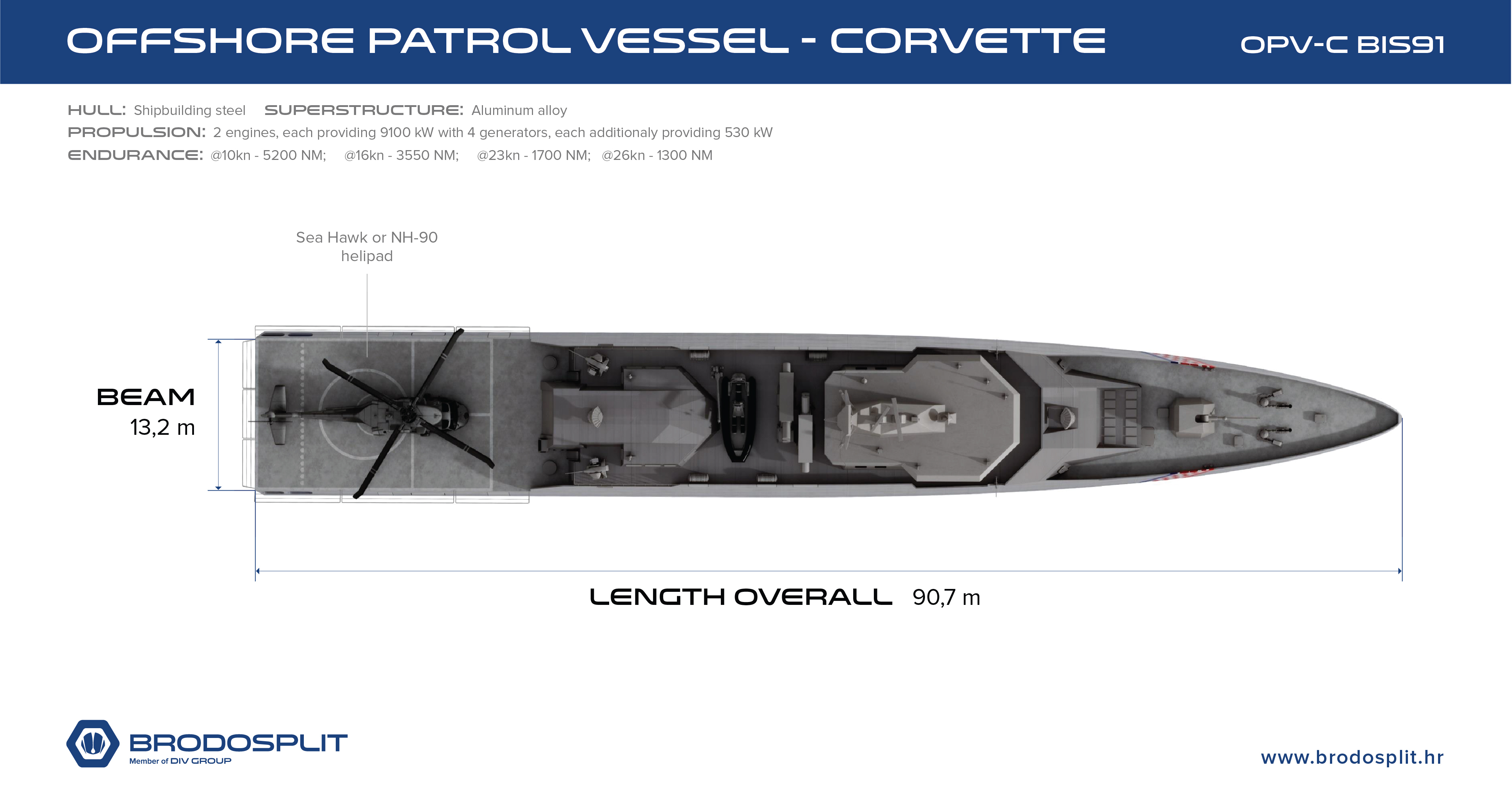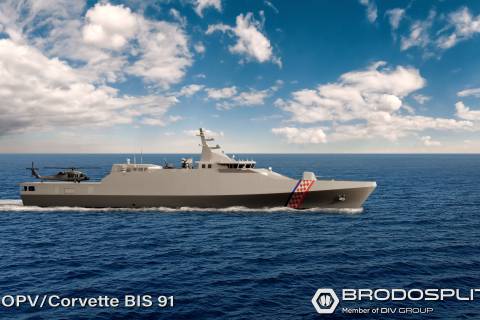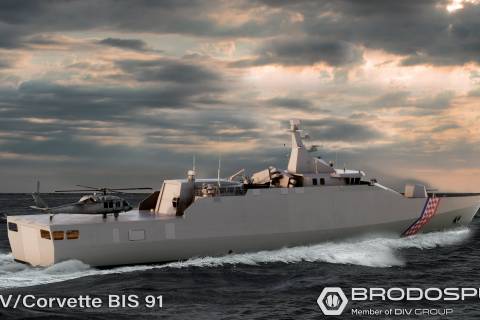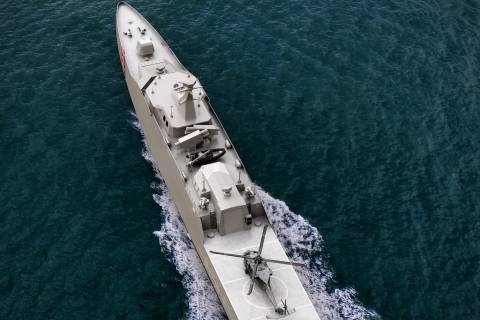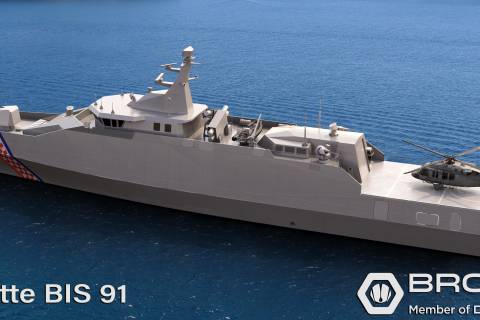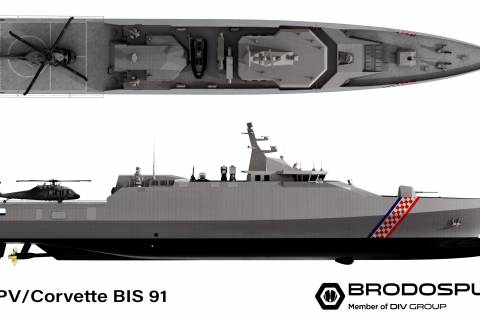BASIC SPECIFICATIONS AND CHARACTERISTICS
1.1. CHARACTERISTICS AND FUNCTION
Warship/patrol vessel of multi-purpose/modular design.
Basic specifications:
- Length (LOA) – 90.7 m
- Hull height at midship section – 7.0 m
- Draught (T) – 4.0 m
- Beam (B) – 13.2 m
- Displacement (D) – 2100 tons
The corvette will be equipped with one intercept vessel up to 13 m long, intended for rescue and intervention, which will be able to reach a maximum speed of at least 40 knots, as well as accept and transport at least 10 people. The vessel will be lowered and raised by a fast stern ramp, at sea state not exceeding 4.
The corvette will be equipped with two cranes designed to load intermodal containers, supply cargo warehouses, and carry equipment for removing oil pollution from the sea. The corvette is planned to accommodate one naval helicopter (NH-90 or Sea Hawk) in collapsible storage on deck. Take-off/landing equipment according to NATO STANAG standards is also provided.
It is also planned to accommodate one unmanned aerial vehicle specialized for use at sea for reconnaissance and observation activities with the possibility of transmitting the recordings of the surface condition to the mothership in the areas where the vessel performs its tasks. The helicopter platform at the stern of the ship will also be used to operate the unmanned aerial vehicle.
To improve stability, vessels will be equipped with an active stabilization system. The corvette will be structurally prepared for the installation of additional equipment on both sides of the bridge deck.
The low silhouette of the hull and the compactness of the superstructure will have a beneficial effect on reducing the visual and radar visibility of the corvette. To reduce thermal visibility, the emissions of all diesel engines will be taken into the sea. To reduce magnetic visibility, i.e., the protection against magnetic and induction mines, the corvette will be equipped with an automatic system for compensating its magnetism.
Ship equipment includes mechanisms, devices, installations, systems, tools, instruments, and other systems that are assembled and delivered with the ship and necessary for proper functioning.
The propulsion system allows the following:
- Maximum speed – 26 knots
- Patrol speed (optimum speed) – 22 knots
- Electric propulsion maximum speed – 10 knots
- Cruising range at 16-knots speed – at least 3000 NM
A bow thruster will be installed to improve agility.
The corvette will be equipped with X-band navigation radars with a capacity of at least 25 kW and S-band radars with a capacity of at least 30 kW. The ECDIS electronic chart system installed must cover all the specified areas of operation of the vessel. The vessel will be equipped with a VHF radio station with a multi-mode airborne radar, UHF radio station, AIS system. The corvette will have a long-range surveillance system, daylight and thermal imaging in the form of a gyro-stabilized optoelectronic sensor. The corvette will be equipped with two navigation reflectors, its radio station, and a tracking system.
1.2. OPERATIONAL AREA
Unlimited.
1.2.1. Maritime and maneuverability specifications
The corvette is designed for:
- Full operation at sea state up to 5 according to WMO, including military helicopter reception
- Safe use (raising/lowering) of the RIB interceptor at sea state 4
- Limited operability at sea state up to 6
- Sailing with maximum continuous power at sea state 4 – 5 according to WMO
The corvette will meet the requirements of NATO STANAG 4154.
Maneuverability
The corvette will be able to maneuver without the tug or other vessel at low speeds, especially when passing through narrow passages and canals and when mooring and unmooring with a wind up to Beaufort force 8, considering the resulting sea currents in the specified areas stated in 1.3.
The corvette’s maneuverability presupposes ensuring the maneuverability and stability of the course, the possibility of emergency stopping for safe navigation, and meeting maneuvering standards following IMO standards.
1.2.2 The corvette’s speed
The corvette can reach the speed of 26 knots in the following conditions:
- complete crew and equipment
- 50% fuel, oil, food, water, and black water tanks.
- sea depth not less than 30 m
- sea state, not more than 2, wind speed up to 3.3 m/s
1.3. CREW, SUPPLIES, AUTONOMY, CRUISING RANGE
Crew
The corvette accommodates 71 crew members including:
- 61 crew members
- 10 additional support staff
Autonomy
The autonomy of the corvette is over 30 days with 71 crew members and support staff. The corvette will have secured containers for separate waste storage and packaging following the "MARPOL" convention.
1.3.1. Cruising range
The cruising range of the corvette is 3000 NM.
The arrival of the ship is 3000 nm in navigation at an optimum speed of 16 knots and assuming that 10% of the fuel remains in the tanks.
Material and construction
The hull is constructed of shipbuilding steel of standard bulbous profiles, I profiles (strips), and crafted T-profiles. The superstructure will be constructed of AlMg4.5Mn aluminum alloy sheets, standard I profiles (strips), and crafted T-profiles.
COMBAT SYSTEM
Corvette BIS 91 is designed as a multi-purpose warship performing general combat tasks that include artillery operations on the surface, air, and coastal targets, effective medium-range anti-aircraft combat, effective long-range combat on the surface and coastal land targets, anti-submarine combat, and close air defense of the vessel as well as defense against all forms of asymmetric threats.
The combat system for BIS 91 structurally consists of three segments, as follows:
- Weapons system
- Sensor system
- Combat management system (CMS)
Weapons system
BIS-91 is equipped with the following weapons system to perform all the necessary tasks in terms of combat operations:
- Bow gun – main caliber 76mm (optional 57mm) located on the bow of the corvette
- Anti-aircraft missiles system with a vertical launch located on the bow of the corvette, behind the main cannon
- A long-range anti-ship missile defense system located on the superstructure behind the wheelhouse
- Light torpedo system for anti-submarine combat – located on the stern of the main deck
- Remotely controlled locally stabilized small-caliber cannons (up to 30 mm), 2 pcs., intended for close defense – located on the deck of the superstructure on both sides of the ship (optional and light missiles)
- Remotely controlled heavy-duty 12.7 mm machine guns (2 pcs.) for close defense and protection of the ship from possible asymmetric threats – located on the deck of the superstructure.
Sensor system
The corvette’s sensor system required for the efficient use of the described weapons system consists of:
- 3D observation radar as the main monitoring system onboard (Identification Friend or Foe – IFF). The antenna part of the system is located at the top of the mast while the transceiver is placed in the technical room near the vessel’s combat operational center.
- Radar and EO (electro-optical) fire monitoring and control system according to monitored targets. The antenna part of the system is located above the wheelhouse, while the auxiliary systems are in the technical room at the vessel’s combat operations center level.
- Anti-submarine sonar in the hull of the ship. The antenna is located in the hull of the ship.
- Electronic warfare system:
- radar detector (radar jamming system optional) (electronic countermeasure – ECM). The antenna parts are placed on the mast.
- two decoy launching systems, one located on the bow (covering the bow sector) and the other on the stern (covering the stern sector).
Combat Management System (CMS)
The CMS system is based on a fully open and distributed computer hardware and software configuration with all the necessary interfaces of the vessel’s sensor and weapon systems and the necessary operator panels for quality graphical presentation of the tactical air, surface, and underwater situation around the ship necessary for the analysis, situation assessment, acquisition, and monitoring goals, as well as making timely decisions on the action. The presentation part of the system (operator panels) is in the vessel’s combat operational center, while the necessary hardware devices (servers) can be placed in a separate room.
The core of the system consists of a console networked with the operator consoles of the sensor part of the system (3D radar, FCR + EOS) (also a bow cannon console), sonar, ECM, MASS-decoy) and operator panels of the remote-controlled guns to send an indication of the target that is a potential threat.
To be fully operable, the CMS links to the corvette’s navigation (radar, gyro, anemometer) and communication systems of the internal and external vessel’s connection.
Part of the CMS is a special gyro vertical (laser or fiber optic gyro (3D)), as well as a special anemometer (for calculating ballistic wind).
